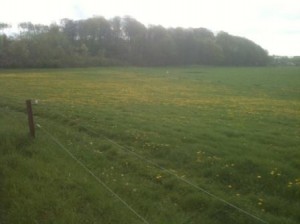 We profited from International Labour Day this morning to take a nice long walk. In the picture is a field – presumably untreated – full of dandelions in full bloom. I think I have written a post about a similar spectacular sight in the past. One could imagine a farmer in Gormenghast growing fields of dandelions, nettles, thistles and cow parsley (imagine the yellows, dark greens, mauves and whites!). They would be every bit as spectacular as the fields of colza that are just coming into flower now. May Day, like Christmas and Easter, is a very ancient festival, though somehow left secular as the Roman Catholics took over and transformed most ancient festivals. International Workers’ Day, on the other hand, is a much more recent creation, dating from the 1880s and 1890s. Specifically, it commemorates the 1 May 1886 Haymarket Massacre in Chicago, when the city’s police, provoked by an indiscriminate dynamite bomb attack, fired onto a striking crowd demonstrating in favour of the eight-hour week, killing dozens of people, including some policemen. In 1891 the Second International’s Congress (Paris) formally recognised the commemorative demonstrations as an annual event and in 1904 the International Socialist Conference (Amsterdam) declared 1st May to be a more general demonstration of workers’ rights.
We profited from International Labour Day this morning to take a nice long walk. In the picture is a field – presumably untreated – full of dandelions in full bloom. I think I have written a post about a similar spectacular sight in the past. One could imagine a farmer in Gormenghast growing fields of dandelions, nettles, thistles and cow parsley (imagine the yellows, dark greens, mauves and whites!). They would be every bit as spectacular as the fields of colza that are just coming into flower now. May Day, like Christmas and Easter, is a very ancient festival, though somehow left secular as the Roman Catholics took over and transformed most ancient festivals. International Workers’ Day, on the other hand, is a much more recent creation, dating from the 1880s and 1890s. Specifically, it commemorates the 1 May 1886 Haymarket Massacre in Chicago, when the city’s police, provoked by an indiscriminate dynamite bomb attack, fired onto a striking crowd demonstrating in favour of the eight-hour week, killing dozens of people, including some policemen. In 1891 the Second International’s Congress (Paris) formally recognised the commemorative demonstrations as an annual event and in 1904 the International Socialist Conference (Amsterdam) declared 1st May to be a more general demonstration of workers’ rights.
Leave a Reply